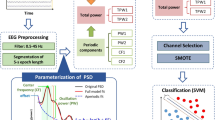Abstract
In this paper the EEG signal is analyzed by reconstructing the time series EEG signal in High dimensional Phase Space. The computational complexity in higher dimension is reduced by Principal Component Analysis for the High dimensional Phase Space output. Poincare sectioning is done for the first and second Principal Components (PCs). The intersection points of PCs and the Poincare section are collected and used for features calculation. Two layer of classification is done using SVM as first layer and Naive Bayes as second layer. The proposed methodology is evaluated using the CHB-MIT database for 23 subjects. The results are obtained using different channel combinations of EEG signal and highest of 95.63% accuracy, 95.7% sensitivity and 96.55% specificity is obtained for 12 electrode combinations which include electrodes from parietal and occipital lobes. This infers that most of the subjects have dysfunction in hearing (controlled by parietal) and vision (controlled by occipital) during the time of seizure. This GUI has channel selection option and seizure detection for every channel (23) for every 1 s.



Similar content being viewed by others
Availability of data materials
The Database used for evaluating the performance is that CHB-MIT benchmark Database. It contains the EEG recordings of 23 subjects of various age groups. The sampling frequency of each recording was 256 Hz with 16 bit resolution. The International 10–20 electrode system was followed to record the EEG signal. The 23 common channels are FP1-F7, F7-T7, T7-P7, P7-O1, FP1-F3, F3-C3, C3-P3, P3-O1, FP2-F4, F4-C4, C4-P4, P4-O2, FP2-F8, F8-T8, T8-P8, P8-O2, FZ-CZ, CZ-PZ, P7-T7, T7-FT9, FT9-FT10, FT10-T8, and T8-P8
References
Mukhopadhyay, K. R. et al., Epilepsy and its Management: A Review. Journal of PharmaSciTech 1(2):20–26, 2012.
W. H. Organization. Fact sheet N°999, 2017. Available: http://www.who.int/mediacentre/factsheets/fs999/en/.
Pubmed, Epilepsy:An Overview. 2016. Available: https://www.ncbi.nlm.nih.gov/pubmedhealth/PMH0084513/.
Zhang, J., Zou, J., Wang, M., Chen, L., Wang, C., and Wang, G., Automatic detection of interictal epileptiform discharges based on time-series sequence merging method. Neurocomputing 110:35–43, 2013.
Shantha Selva Kumari, R. and Prabin Jose, J., Seizure detection in EEG using time frequency analysis and SVM. Emerging Trends in Electrical and Computer Technology (ICETECT ), 2011.
Blanke, O., Lantz, G., Seeck, M., Spinelli, L., Grave de Peralta, R., Thut, G., Landis, T., and Michel, C. M., Temporal and spatial determination of EEG-seizure onset in the frequency domain. Clin. Neurophysiol. 111(5):763–772, 2000.
Mohseni, H. R., Maghsoudi, A and Kadbi, M. H., Automatc detection of epileptic seizure using time-frequency distributions. Advances in Medical, Signal and Information Processing, 2007.
Brignol, A., Al-ani b, T., and Drouot, X., Phase space and power spectral approaches for EEG-based automatic sleep–wake classification in humans: A comparative study using short and standard epoch lengths. Comput. Methods Prog. Biomed. 109(3):227–238, 2013.
Jeong, J., Kim, D., Chae, J., Kim, S. Y., Ko, H., and Paik, I., Nonlinear analysis of the EEG of schizophrenics with optimal embedding dimension. Med. Eng. Phys. 20(9):669–679, 1998.
Wei, Z., Hongxing, L., and Jianchun, C., Adaptive filtering in phase space for foetal electrocardiogram estimation from an abdominal electrocardiogram signal and a thoracic electrocardiogram signal. IET Signal Processing, 2012.
Takens, F., Detecting strange attractors in turbulence. Lecture Notes in Mathematics 898:366–381, 1981.
Kolemen, E., Jeremy Kasdin, N., and Gurfil, P., Multiple Poincaré sections method for finding the quasiperiodic orbits of the restricted three body problem. Springer 112(1):47–74, January 2012.
Zabihi, M., Kiranyaz, S., Analysis of high-dimensional phase space via Poincaré section for patient-specific seizure detection. IEE Transactions on Neural Systems and Rehabilitation Engineering, 24(3), 2016.
Rafiuddin, N., Uzzaman Khanm, Y., and Farooq, O., Feature Extraction and Classification of EEG for Automatic Seizure Detection," in International Conference on Multimedia, Signal Processing and Communication Technologies, Aligarh, 2011.
Uzzaman Khan, Y., Rafiuddinm, N., and Farooq, O., Automated seizure detection in scalp EEG using multiple wavelet scales. In Signal Processing, Computing and Control (ISPCC), 2012 IEEE International Conference on, Waknaghat Solan, 2012.
Hunyadi, B., Signoretto, M., Van Paesschen, W., Suykens, J. A. K., Van Huffel, S., and De Vos, M., Incorporating structural information from the multichannel EEG improves patient-specific seizure detection. Clin. Neurophysiol. 123(12):2352–2361, 2012.
Children’s Hospital, Boston-MIT Database. Available: https://physionet.org/cgi-bin/atm/ATM.
Goldberger, A. L., Amaral, L., Glass, L., Hausdorff, J. M., Ivanov, P. C., Mark, R. G., Mietus, J. E., Moody, G. B., Peng, C. K., and Stanley, H. E., PhysioBank, PhysioToolkit, and PhysioNet: Components of a New Research Resource for Complex Physiologic Signals. Circulation 101(23):e215–e220, 2000.
Author information
Authors and Affiliations
Corresponding author
Ethics declarations
Ethical approval
This article does not contain any studies with human participants performed by any of the authors.
Conflict of interest
No conflict of interest.
Additional information
Publisher’s Note
Springer Nature remains neutral with regard to jurisdictional claims in published maps and institutional affiliations.
This article is part of the Topical Collection on Patient Facing Systems
Rights and permissions
About this article
Cite this article
Selvakumari, R.S., Mahalakshmi, M. & Prashalee, P. Patient-Specific Seizure Detection Method using Hybrid Classifier with Optimized Electrodes. J Med Syst 43, 121 (2019). https://doi.org/10.1007/s10916-019-1234-4
Received:
Accepted:
Published:
DOI: https://doi.org/10.1007/s10916-019-1234-4




